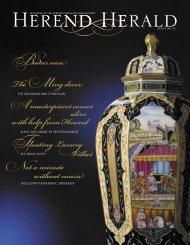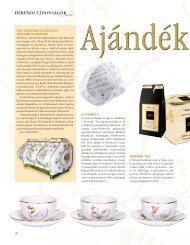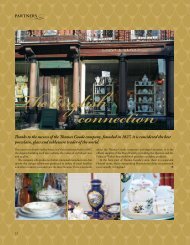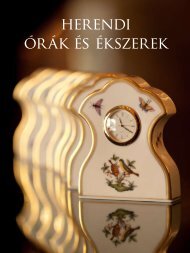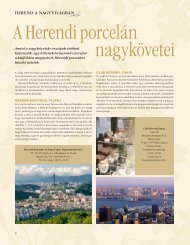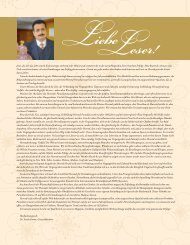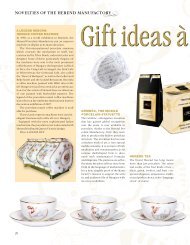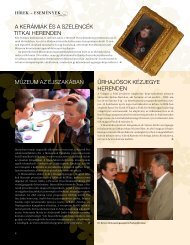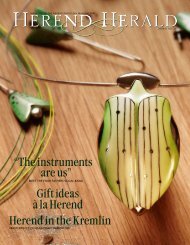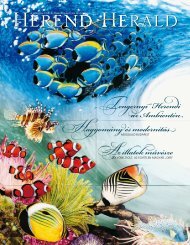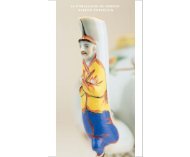ALL ABOUT HEREND
All about Herend_EN_nyomdai.pdf
All about Herend_EN_nyomdai.pdf
- No tags were found...
Create successful ePaper yourself
Turn your PDF publications into a flip-book with our unique Google optimized e-Paper software.
<strong>ALL</strong> <strong>ABOUT</strong> <strong>HEREND</strong><br />
<strong>HEREND</strong> PORCELAIN MANUFACTORY LTD.<br />
HUNGARY
1
Preface<br />
The unique chinaware of the Herend Porcelain Manufactory Ltd. made<br />
with special workmanship is available in over fifty countries around the<br />
world. Porcelain-lovers identify standards of artistic excellence and<br />
impeccable quality with the Herend brand name.<br />
What makes Herend porcelain unique and different from the products of<br />
other makers?<br />
• High-quality manufacturing technology<br />
• Handpainting<br />
• Rich selection of forms and décors<br />
• Life-time guarantee of replacement pieces<br />
• Capability to produce custom-made pieces to satisfy special requests<br />
(bespoke service)<br />
• Prominent customers<br />
• 180 years of professional expertise and continuous innovation<br />
• Herend is the biggest and one of the most successful manufactories in<br />
Europe<br />
1. The Birth and History of Herend<br />
When did the Herend manufactory start?<br />
The manufactory was founded in 1826 by Vince Stingl in the town of Herend<br />
near Lake Balaton, the biggest lake in Central Europe. In the early years the<br />
ceramics workshop turned out earthenware and focused on research work for<br />
porcelain development. It was not until 1839, when ownership of the<br />
manufactory passed to Mór Fischer, that real porcelain-making began. It<br />
continues to be the main profile of the manufactory to this very day. While<br />
kaolin, the main ingredient of porcelain, was not to be found in the Bakony Hills<br />
(where Herend is situated), there was plenty of firewood needed to stoke the<br />
kilns.<br />
Herend: Royal Purveyor by Appointment to the House of Habsburg<br />
Herend won a prize at the 1851 Great Exhibition in London and has since been<br />
the beneficiary of royal and aristocratic patronage. In 1872, Mór Fischer, then<br />
owner of the Herend manufactory, was appointed purveyor to the Royal and<br />
Imperial Court.<br />
2
Herend and the World’s Fairs<br />
World’s Fairs had become synonymous with economic prosperity in Europe by<br />
the late 19 th century. The latest technologies and industrial machinery were<br />
showcased on such occasions, and the art, objects and works of art, of different<br />
nations were made accessible to the public at large. Herend always made a point<br />
of being present at these events, which earned numerous awards.<br />
How many people work at the porcelain manufactory?<br />
The total number of people employed at Herend approaches the 950 mark.<br />
Among them are 420 painters and 100 throwers (who do the piercing and the<br />
hand moulding). As regards the number of workers Herend is the biggest<br />
porcelain manufactory in Europe.<br />
2. Raw Materials and Manufacturing Process<br />
The raw materials of Herend porcelain are:<br />
Kaolin, feldspar and quartz. The latter two increase the translucency of<br />
porcelain. Since these materials are not found in and around Herend, they are<br />
imported from Limoges, France. Herend’s secret lies in the paste used to make<br />
the porcelain. The aim is to make the thinnest, whitest, lightest and finest<br />
products possible.<br />
What is Herend’s system of master craftsmen?<br />
First introduced in the German town of Nuremberg in the 15 th century, the<br />
system of ranking artisans served the training of master craftsmen. At the time<br />
of the Industrial Revolution in 19 th -century England the system fell into disuse<br />
in most countries. At Herend, however, this medieval tradition has lived on and<br />
continues to serve the training of talented new “heirs” as well as the<br />
safeguarding of traditional technology.<br />
Master Painter (a master in painting)<br />
The title of “Master Painter” is awarded to those graduates of the 3-year course<br />
of the manufactory’s own vocational school who have years of professional<br />
practice and have passed the “master exam”.<br />
Candidates for Master Painter (those preparing for the master painter exam)<br />
This title is granted to painters who have excelled with their achievement and<br />
talent. They are entitled to sign the items they have painted. Candidates for<br />
Master Painter produce unique and special objects which require great expertise<br />
and experience.<br />
Master thrower (a master in throwing)<br />
3
Similarly to master painters, throwers too are to pass a professional exam if they<br />
are to attain the title of master thrower. In order to pass this exam, examinees are<br />
required to know all the theoretical and practical techniques involved in<br />
throwing: manual pressing, throwing, sticking (tableware, ornaments, figurines),<br />
manual moulding (flower-making), piercing, (basket) weaving.<br />
The main activities of throwers:<br />
1. manual forming (flower-making)<br />
Making roses, carnations and all sorts of other flowers, leaves and stems. A<br />
good example of this sort of work is the bud handle on the lid of tea or coffee<br />
pots. Rosebuds of this kind are made from a few petals in a matter of seconds<br />
by experienced throwers.<br />
2. manual pressing<br />
This is the oldest manufacturing technique. The paste is thrown by hand into<br />
the plaster mould (negative), is pressed and removed. This technique is used<br />
for making fruit, for example.<br />
3. basket weaving<br />
Long strips of paste fondly called spaghetti are placed side by side on a<br />
plaster mould. The thus woven basket is very elaborate and fragile, a true<br />
Herend special.<br />
4. piercing<br />
Piercing is a method whereby little holes or windows are cut with a sharp<br />
two-edged knife in the already moulded but only half-dry paste. As the piece<br />
is not completely dry yet, it is very fragile, so great caution is needed during<br />
handling. While some pieces need no more than 15-20 minutes to complete,<br />
others may take a whole day to pierce.<br />
5. double wall<br />
A method frequently used for pieces such as tea cups. So that pierced objects<br />
can also be used for practical purposes, an inner wall is placed within the<br />
pierced outer wall. First the inner and outer cups are moulded and joined<br />
before drying. Naturally, only the outer cup is pierced. The technique<br />
requires great caution in order to prevent the cut away pieces of paste from<br />
falling between the two walls of the cup. The Wales service is a typical<br />
example of this kind of double-wall Herend product.<br />
4
The Process of Making Porcelain<br />
MOULDING<br />
THROWING<br />
animal,<br />
figurine,<br />
soup bowl,<br />
sauceboat,<br />
etc<br />
cup, saucer,<br />
plate, etc.<br />
biscuit firing<br />
at 980 ◦ C<br />
faulty items are<br />
rejected, good ones<br />
are approved<br />
glost firing<br />
at 1380 ◦ C<br />
faulty items are<br />
rejected, good ones are<br />
approved<br />
glazing<br />
quality<br />
control<br />
quality<br />
control<br />
faulty items are<br />
rejected, good<br />
ones are approved<br />
reparable<br />
items are<br />
repaired<br />
painting<br />
repeated (and final)<br />
quality control in the<br />
painting section<br />
faulty items<br />
are rejected<br />
firing at<br />
750-850 ◦ C<br />
*the number of firings<br />
depends on the type<br />
of paint used<br />
decoration<br />
branding<br />
final firing<br />
at 680 ◦ C<br />
*the last firing after<br />
gilding<br />
quality<br />
control<br />
only first class products<br />
make the grade<br />
5
3. Types and Forms of Products<br />
Herend products fall into the following seven categories:<br />
1. services<br />
Traditional European tea and coffee sets as well as dinner services, which range<br />
from products for everyday usage to exotic pieces specially decorated with<br />
Chinoiserie and Persian motifs.<br />
2. gifts<br />
Interior ornaments for tables, such as bonbonnieres, bowls and ashtrays with<br />
lids.<br />
3. ornaments<br />
Wall plates, vases, cups, ornamental plates, etc. in traditional European style as<br />
well as other styles influenced by Persian, Chinese and Japanese art.<br />
4. animal figures<br />
These figures make up a whole zoo of well-known and quite extraordinary<br />
species. The figures are made in two styles: one in naturalistic style and the<br />
other with Herend’s very own special scale pattern.<br />
5. figurines<br />
Human figures portrayed in European, Persian, Hungarian and Oriental styles.<br />
6. jewellery<br />
A variety of custom jewellery, figure pendants.<br />
7. special objects<br />
These may vary from a one-metre-diameter pierced platter, through a largerthan-human-size<br />
vase or a double-walled flask, to unique pieces made for state<br />
occasions or any other commemorative event.<br />
The speciality of form<br />
Herend has developed a tremendous variety of both sizes and forms as a result<br />
of the wide spectrum of customers it has received and served from Europe and<br />
all over the world. This variety is further enhanced by old forms being<br />
modernized. Herend’s current storehouse of forms comprises some 15,000<br />
pieces, which is expected to grow year by year. The forms adhere to stylistic<br />
features of different periods of art, such as Baroque, Rococo, Empire or Art<br />
Nouveau. Products in the Persian and Chinese style make up another numerous<br />
group, displaying manufacturing traits not characteristic of other brands.<br />
6
4. Painting<br />
Is all Herend porcelain handpainted?<br />
Absolutely. No exception. The overwhelming majority of Herend painters learn<br />
their trade at the manufactory’s own school. Following the three-year course the<br />
painters specialize in different styles and motifs, each one according to his or her<br />
skills. The different branches of painting have traditionally covered figure<br />
painting, Chinese and Japanese style décors, fruit painting and varieties of<br />
flower painting. In each department a painter will paint a given motif from start<br />
to finish. Gilding may be an exception to this rule, as it is usually done at a later<br />
stage, depending on the pattern, in a gilding studio. Most of the décors are<br />
painted within outlines. The outlines are meant to ensure that the patterns are the<br />
same size and form irrespective of the painter and the time of painting. The<br />
painters draw the outlines with metal-tipped pens and subsequently apply the<br />
different colour paints.<br />
How many times is a product fired after painting?<br />
Depending on the type of décor some products are fired only once, while others<br />
need various firings. This is necessary because a décor may consist of varying<br />
paints that have to be fired at different temperatures. The painting process<br />
begins with paints that burn at a high temperature, and the “firing-painting”<br />
cycle is repeated as many times as necessary.<br />
What kinds of firing techniques are used at Herend?<br />
They are the following:<br />
1. over glaze<br />
In this method the already fired and glazed surface is painted and refired at<br />
approx. 820C. Practically all décors are made this way.<br />
2. in-glaze<br />
This method is similar to the over glaze method up to the point where the<br />
already fired and glazed surface is painted. In the case of “in-glaze” technique,<br />
however, the firing temperature is 1250C and as a result the paint blends into the<br />
glaze. The method is used for only a number of patterns.<br />
7
5. Décors<br />
Even apparently identical décors can be different.<br />
Due to the fact that all items are individually handpainted, minor alterations are<br />
noticeable. Such an example can be the colour of the rose handles, one of<br />
several cases when the personality of a painter becomes manifest. In other<br />
words, a piece of Herend porcelain can thus become unique in the world.<br />
Meticulous attention is devoted to quality control. For a product to pass all the<br />
checks it has to satisfy a surprisingly great number of conditions. This quality<br />
assurance system was certified ISO9001* in 1994.<br />
* ISO9001 is an international quality assurance and management system certificate<br />
How many Herend décors are there?<br />
Over two thousand. The technological description as well as the blueprint of all<br />
the décors is kept in the archives.<br />
Why are Herend patterns so varied?<br />
Herend has acquired the stylistic features of the European cultural heritage,<br />
which is emphatically reflected in its décors. The Herend trademark is a<br />
combination of light-hearted Mediterranean, sophisticated French, robust<br />
German and the cutely simple but smart Habsburg style (Biedermeier). Persian<br />
and Chinese-style décors enhance originality, the unique nature of the art that is<br />
the manufactory’s own.<br />
Is “Chinoiserie” a Herend specialty?<br />
Chinoiserie goes back a long time in Europe. The 19 th century witnessed the<br />
awakening of interest towards the world outside of Europe, and the fledgling<br />
manufactory at Herend, understandably swayed by the prevailing trends, delved<br />
into the world of Chinoiserie.<br />
Who is the little Chinaman on the cup handles?<br />
We call this figure a mandarin, a word for a Chinese government official in<br />
former times. How it was born is not known to this very day; in all probability it<br />
is a Herend special. It may be assumed that Mór Fischer saw many Chinese<br />
figures at the World’s Fairs he frequented, and he playfully merged those with a<br />
Chinese-style décor. The humorous faces of these little figures certainly puts a<br />
smile on everybody else’s face.<br />
8
Typical patterns<br />
VBO: This is the décor Queen Victoria first saw and immediately purchased at<br />
the 1851 Great Exhibition. This earned Herend overnight recognition<br />
worldwide. As well as winning the Grand Prix at that world’s fair, Herend was<br />
flooded with orders from the English aristocracy. This décor is still the most<br />
sought after in Britain where it honours many an upper-class family’s table.<br />
RO: This décor was named after the Rothschild family, who first ordered it in<br />
1850. As the Rothschilds invested a great deal in Herend, it is fair to assume that<br />
they ranked among the manufactory’s VIP clients. Legend has it that Baroness<br />
Rothschild’s lost necklace was found twined around the branch of a tree, which<br />
is what the décor depicts. The other legendary figure associated with this décor<br />
is the late Princess Diana, who chose this service for her wedding day.<br />
AV, AF: Based on the Fleurs de Indes décor, this pattern was created for Count<br />
Apponyi of Hungary, who ordered a new dinner service from Herend with the<br />
utmost urgency to be able to attend his guests in good style. Being equal to the<br />
task was no mean challenge for the manufactory, which came up with a simpler<br />
version of the Fleurs des Indes pattern as a final solution. This way the count’s<br />
whim indirectly gave birth to this later highly popular décor. In fact, according<br />
to some sources, even the Habsburgs ordered porcelain with this pattern.<br />
TCA: This splendid décor incorporating adaptations of Persian miniatures was<br />
first made in the 1870s for the Shah of Persia. It is such an intricate pattern that<br />
it needs to be fired five times before it is ready. A whole dinner service takes<br />
two full months to make. The combination of Turkish blue and scarlet gives it a<br />
real Oriental air. Part of its full name, Tupini dates back to Roman times, when<br />
it was an ancient family name. This décor has enjoyed great popularity for a<br />
long time.<br />
PO: “Poissons” means fish in French. Fish, especially carp, is a motif that<br />
symbolizes good luck in China and is, therefore, frequently used in art. The<br />
Chinese objects that arrived in Europe from the 18 th century on were richly<br />
decorated with fish, which is something Herend adapted and made famous in the<br />
1850s.<br />
G: This décor, bearing the notable influence of the Kakiemon style, consists<br />
mainly of a combination of pine, bamboo and plum blossom, the “three friends<br />
of the cold season” in China. It was first made in 1849 as the first Herend<br />
Chinoiserie pattern and was named after the Gödöllő Mansion in Hungary. It<br />
9
was there that that the dinner service with this décor, given as a gift to Queen<br />
Elisabeth by Emperor Franz Joseph, was first used.<br />
VH: The starting point for this décor, first handcrafted in the 1860s, was the<br />
reproduction of Chinese enamelwork. All the individual strokes of the scale-like<br />
pattern are handpainted. VH figurine collectors abound in both Europe and<br />
America, including the late Princess Diana and movie star Arnold<br />
Schwarzenegger.<br />
6. Briefly about Herend<br />
How is Herend different from other brands?<br />
If we classify porcelain according to how it is painted (i.e. handpainted or<br />
transferred), Herend belongs to the handpainted category, which is less and less<br />
common nowadays. One of Herend’s main features is its wide variety of<br />
Chinoiserie patterns. While it has a whole series of these, many of its other<br />
European-style patterns also betray a strong Chinese or Japanese influence. This<br />
may be put down to the Hungarians’ Asian roots as well as the age when the<br />
manufactory was founded, as these were prevailing fashions in the 19 th century.<br />
As part of the Habsburg cultural sphere, furthermore, Herend produced<br />
characteristically rich decorations and a wide variety of pieces. Other brands,<br />
such as English porcelain for instance which reflects the English cultural<br />
heritage, are far less opulent as regards forms. Herend, on the other hand, is a<br />
true reflection of the cultures that belonged to the world of the Habsburgs.<br />
What does the inscription on the underside mean?<br />
Since the factory was founded in 1826 over 60 hallmarks, including ones only<br />
introduced on special occasions, have been used. The current hallmark has been<br />
in use since the early 1960s. It bears the initials HP (Herend Porcelain) above<br />
the coat of arms of the Republic of Hungary. Beneath the hallmark figures the<br />
product number, the décor name, and the date (year and month) of manufacture.<br />
The next line contains the painter’s code (3 digits at most), which identifies the<br />
craftsman who made the piece.<br />
Can Herend porcelain be purchased anywhere in the world?<br />
Herend porcelain is sold in some 60 countries around the world. Herend often<br />
manufactures exclusive products available only in a given country. The<br />
manufactory strives to satisfy as wide a circle of customers in a given place as<br />
possible with its products and décors. In Hungary, there are ten brand shops,<br />
three of which are in Budapest and the biggest one in Herend.<br />
10
Should I break a cup, can I get one single cup to replace it?<br />
Yes, you can. You can purchase one if the type you need is in stock, otherwise<br />
you can place an order, which will entail a few months’ wait. Bearing in mind<br />
that Herend products are all handpainted, colours may vary slightly. Thank you<br />
for your understanding.<br />
Protection of the environment is high on Herend’s agenda…<br />
Herend cannot turn a blind eye towards problems such as global warming, for<br />
example. Nearer home, Herend is active in protecting the surroundings of the<br />
manufactory, the health of the inhabitants and the state of nature in and around<br />
the rich Bakony Hills. In order to diminish its industrial waste Herend has<br />
installed its own disposal system, and has implemented a training programme to<br />
encourage its workers to play an active part in protecting the environment. In<br />
1996, this initiative was awarded the ISO 14001** certification. Particular<br />
attention is paid to the paints used, with special regard to those that contain<br />
cadmium and lead, which are harmful to health.<br />
**ISO 14001:<br />
environmental management system<br />
ISO: (Geneva-based) International Organisation for Standardisation<br />
Where is Herend?<br />
The town of Herend is situated in the western part of Hungary, some 40 km<br />
north of Lake Balaton. The place has now been granted city status despite its<br />
relatively low population. The main attraction of Herend is the visitors’ centre<br />
called Porcelanium, which houses a mini manufactory where visitors can<br />
become familiar with the different work phases of making porcelain through live<br />
demonstrations. Also part of Porcelanium is the Apicius Restaurant and Coffee<br />
Shop, which rank among the best in Hungary and where the gourmet dishes are,<br />
needless to say, served on Herend porcelain. The Herend Porcelain Museum<br />
offers the most precious collection of Herend porcelain anywhere and boasts the<br />
most outstanding collection of Herend antiques.<br />
11
Herend Chronology<br />
Use of simple garlands and<br />
scattered motifs<br />
1826 The Herend Manufactory is founded<br />
1837<br />
1839<br />
Mór Fischer takes over the management of the<br />
manufactory<br />
Bouquet de Herend 1842<br />
First Applied Arts Exhibition in Hungary –<br />
Herend is discovered<br />
1843 Fire ravages the factory<br />
1848<br />
Gödöllő 1849<br />
Rothschild Oiseaux 1850<br />
Victoria avec bord doré<br />
Poissons<br />
1851<br />
1848-49 freedom fight and revolution<br />
Franz Joseph is crowned<br />
The Great Exhibition in the Crystal Palace,<br />
London – Grand Prix<br />
Queen Victoria orders a dinner service<br />
Cubash 1862 The London World’s Fair<br />
Vielle Rose d’Habsbourg<br />
The old manufactory in Vienna is closed down,<br />
1864<br />
Persil<br />
Herend inherits several décors<br />
Macao<br />
The Paris World’s Fair – silver medal<br />
1867<br />
Siang Noir<br />
The OMM is created<br />
Tupini Corne d’Abondance 1870<br />
Fleurs des Indes 1870<br />
Lichtenstein Bouquets de<br />
Saxe<br />
1872<br />
Wales 1873<br />
Jardin Mediterraneen 1880<br />
Myosis 1890<br />
Motifs Hongrois 1896<br />
Fleurs au Ruban 1897<br />
Budapest becomes one city as a result of the union<br />
of Buda, Óbuda and Pest<br />
The Vienna World’s Fair – prize for artistic<br />
excellence<br />
The Millennium (commemoration of 1000 years of<br />
Hungarian statehood)<br />
1899<br />
Fraises en Lacis de Trainasse 1900 The Paris World’s Fair – Grand Prix<br />
Fleurs des Champs 1901 The St.Petersbourg World’s Fair – Grand Prix<br />
1914<br />
1923 The manufactory becomes a joint stock company<br />
Apponyi vert, orange 1931<br />
1935 The Brussels World’s Fair – Grand Prix<br />
1948 The manufactory becomes state property<br />
1993<br />
Herend becomes a joint stock company with 75 %<br />
worker ownership<br />
Schrammel figurines 1999 Porcelanium opens<br />
2000 Reconstruction of the Herend Porcelain Museum<br />
Victoria décor revamped 2001 175 th Jubilee celebrations<br />
2002 Queensberry – Hunt Herend porcelain designs<br />
Queen Victoria<br />
ascends the throne<br />
Biedermeier period<br />
Revolutionary<br />
wave sweeps<br />
across Europe,<br />
France and Vienna<br />
War between<br />
Prussia and France<br />
The German<br />
Empire is<br />
proclaimed<br />
Beginning of<br />
Classicism as a<br />
school of art<br />
Beginning of Art<br />
Nouveau in Vienna<br />
World War I breaks<br />
out<br />
12
13
14
WWW.<strong>HEREND</strong>.COM<br />
15



